Trying to push a new idea in engine or chassis design on the buying public can be a risky proposition. If the idea is a hit, great--the motorcycle sells like gangbusters, and both customers and manufacturer are happy. If the concept bombs, however, it can be an expensive mistake for the factory, especially if a particular model is built around that idea. All the development and tooling costs, plus unsold units languishing in a warehouse, can really put the financial hurt on a manufacturer. Just ask Bimota about the Vdue.
But if you were to tack those ideas onto a tried and true model with a loyal following, that risk is lessened considerably. Especially a bike whose fans aren't averse to those new systems adding a little weight and cost, even in an era of ever-lighter supersport machines competing in a marketplace so fierce that price is nearly as important as performance.
Honda's Interceptor--previously known as the VFR--is one of those enduring machines that continues to sell well. Since its ground-breaking debut in 1983 as a cutting-edge sportbike, the Interceptor has been steadily softened and rounded in subsequent generations from its original hard-core premise, while other Honda models took up the all-out performance corporate sword. Although the Interceptor's V4 motor was the basic platform for Honda's superbike racing efforts up until the introduction of the RC51 two years ago, the VFR/Interceptor continued to evolve away from the flashy, testosterone-addled persona into a more gentlemanly, utilitarian sportbike. During that time, the Interceptor continued to build a riding clientele that didn't mind paying a little extra for a sporting machine boasting a little performance technology behind its extremely hospitable manners.
The new 2002 model Interceptor, however, features a substantial makeover from the previous generations in several major design areas. The V4 engine has received a couple of updates, most notable of which is Honda's patented VTEC variable valve induction technology. By only actuating two of the four valves in the combustion chamber at lower rpms for improved torque and fuel economy--while using all four at high rpms for top-end power--the VTEC system is designed to offer the best of both worlds (see "Hyper-VTEC or Economy VTEC" sidebar, page 32).
The chassis also gained a few mods aimed at improving backroad handling, and the Interceptor's overall styling was radically altered. While its new angular, four-headlight front end offers an air of aggressiveness, the real news centers around the twin mufflers jutting out from underneath the sharper, more oblique seat/tail section, a la Ducati 916.
So where is the new Interceptor headed? Is it getting sportier? Or is the last Honda V4 sportbike still the user-friendly, do-it-all machine that its loyal fans have grown to know and love?
Dr. Jekyll & Mr. Hyde
The Interceptor has been a "broad range" motorcycling icon in Honda's lineup for over a decade, so it would seem foolish of the company to tamper with that successful formula by leaning toward either end of the sportbike spectrum. Thus, in the typical Honda manner, they decided to expand on both sides--performance and long range comfort.
The basic architecture of the 781cc, V4 motor is unchanged, but there are plenty of minor modifications. Fitting the VTEC system inevitably added weight and cost, so Honda looked to trim the same elsewhere. Camshafts are 300 grams lighter, but more importantly, the cam drive has been changed from gear to chain drive. The new silent-type cam chain eliminates the gear whine that endeared the Interceptor to many, but it also is cheaper to manufacture, and drops 6.2 pounds. However, the engine cases were beefed up for rigidity purposes to complement the stouter chassis and swingarm (more on that later), which gained back 2.5 pounds. Nevertheless, the new Interceptor powerplant scales in 3.4 pounds less than before.
The combustion chamber's included valve angle is slightly narrower at 23 degrees (vs. the previous 26 degrees), but valve sizes and compression ratio remain the same. The more compact combustion chamber works with new 12-hole injectors (vs. the old four-hole type, for finer fuel atomization) and a three-way catalytic converter in the exhaust to run so efficiently that the Interceptor meets the ultra-stringent 2008 emissions standards. All this exhales through the two aforementioned stainless steel under-seat mufflers (that incidentally are 4.2 pounds heavier).
Gearing was also juggled on the new Honda. The final drive is lower courtesy of a one-tooth-smaller countershaft sprocket, but the internal transmission ratios were altered too. First and second gear end up being lower for better acceleration from a stop, but third through sixth gears are slightly wider and taller for more a relaxed touring rpm. The fuel tank capacity was increased from 5.5 to 5.8 gallons for more range.
While most of this sounds like the Interceptor is being refined into a boring tourer, chassis updates were aimed at bolstering its backroad prowess. The main frame's aluminum spars are made from thicker material, increasing overall rigidity by 23.8 percent. The characteristic single-sided swingarm (pivoting in the engine cases, hence the need for their aforementioned strengthening) is 20mm longer, as well as being 12.1 percent stiffer; the lower frame bracket now runs underneath, connecting the two swingarm pivots instead of being simply a mount for the footpeg hangers.
The conventional HMAS (Honda Multi-Action System) cartridge fork has been beefed up from 41mm to 43mm stanchion tubes, with stiffer, linear-rate springs and a touch more compression damping. The rear shock also received a bit more compression damping, plus more rebound.
One more touring aspect deserves mention, though. Finally, after all these years, Honda has acquiesced to everyone's biggest gripe with the Interceptor: hard luggage is now offered as an option. Unfortunately, Honda didn't have any available for us to test; in fact, we didn't even get any photos of the luggage, which are slated to be made by Givi. This ensures that the quality will be up to Honda's high standards; but it also means that they'll be a bit expensive (which is probably why they're offered as an option instead of coming standard with the bike). In order to support the added weight of the bags (with cargo), passenger and the underseat exhausts, the Interceptor's rear subframe is now a huge steel backbone unit; no wimpy little aluminum racer-style subframe here. Of course, this contributes to the new Interceptor's added heft of 508 pounds--a full 25 pounds heavier than the 2001 version.
Givin' It the Whip
As usual with Honda's PGM fuel injection, cold morning startups are a simple affair: turn the ignition key on and hit the starter button. You can ride off immediately, with nary a hiccup or cough in fuel delivery. The exhaust note at idle and low rpms is so quiet, you wonder if the engine is even running; in keeping with the Interceptor's now-gentlemanly status, this is probably a good thing.
Die-hard Interceptor fans will be glad to know that the ergonomics remain unchanged. Only the seat has been altered, with a wider perch and slightly firmer foam; reactions to how comfortable it was was were mixed, with heavier pilots preferring it. The 10mm taller windscreen is effective in keeping the windblast off your chest and helmet, the mirrors are adequate, and the new dash with digital speedo is much easier to read.
So how does the VTEC feel? If you're expecting a cammy rush of power, you'll be disappointed. Honda massaged the fuel delivery and ignition timing maps to ensure that the transition to four-valve breathing at 7000 rpm is as smooth as possible. The motor does seem to accelerate and rev more freely than before, but that acceleration depends on the gearing.
In the city, acceleration from a stop is decidedly brisk, due to the shorter first and second gears. You can dispatch traffic with ease, and the Honda's nimble handling belies its somewhat hefty weight. For the most part, the Linked Braking System functions well in the city, although we still are not fans of the system. Even though this latest version is less "linked" than before, it still requires heavy effort at the lever for serious stopping power unless you use the rear brake pedal simultaneously. Feel and modulation are pretty numb, and the braking power is extremely progressive; there's not much at the beginning, then it increases drastically. Nothing bad, mind you, and for the average rider the brakes are perfectly adequate; we would rather have a choice of which brake and how much, however. (We also had a chance to briefly try the ABS version during wet weather, and can report that its performance was excellent. Quick, controlled stops with no wheel lockup whatsoever.)
Our initial concerns about the increased compression damping at both ends were dispelled when we encountered rough pavement. The suspension soaks up most of the big hits pretty well without transferring the shock loads to the chassis or rider. This is due to the bike's added weight, which gives the damping more inertia to work against. Frost heaves on the highway were more noticeable, but nothing excessive.
The highway is where we found the Interceptor's taller gearing tended to offset any power gains attained by the VTEC. Sixth gear is now more of an overdrive cog, so unless you are doing at least 75 mph (which puts you at 5000 rpm), brisk passing still requires a couple of downshifts. A pretty big flatspot between 4000 and 5000 rpm has the motor working hard to overcome the tall sixth gear, and even a downshift to fifth (which is 2.3 percent taller than before) sometimes isn't enough.
Our fuel mileage--mixing in a few canyon sorties in addition to regular commuting--hovered around the 36 mpg mark, which means that around 200 miles a tankful is possible; the reserve warning begins flashing with about a gallon left. The new headlights are good, with the high beams especially effective at lighting up pavement 500 feet in front of you.
Once into twisty pavement, however, the Interceptor really displays where the changes prove effective. While the old version was no slouch, the new Interceptor's chassis and suspension improvements give it a higher level of stability and control when the pace picks up. Aggressive cornering moves and rough pavement that would get the old model wallowing and chattering are now handled with nary a whimper, with decent ground clearance keeping hard parts off the deck (really aggressive cornering will cause the centerstand and collector pipes on the right side to touch down, but you should be riding a different bike at that point). The suspension rates are a good compromise between long-haul comfort and sporting control.
We found that even while riding aggressively in the tighter canyons, the VTEC's transition to four-valve power was smooth enough to prevent upsetting the chassis or tires while leaned over. Incidentally, the Dunlop D204 Sportmax tires (uh...they still make those?) stuck well, with quick and neutral steering habits; their wear rates were a little excessive, however. Acceleration when constantly accessing the above-7000 rpm powerband feels livelier than the older model, but even when momentarily dropping below 7000 rpm, you never have to be wary of when the VTEC chimes in. A change in intake honk is the only real notice that the system has engaged. Power begins to drop off around the 10,750 rpm mark, so there's no reason to rev it any farther before shifting.
Final Destination
While the VTEC's improvements to engine performance may be less than stellar, it imbues a modicum of personality to the Interceptor, and there are some tangible gains in the tighter canyons. Once into the faster stuff, however, the motor doesn't matter--the improved chassis and suspension take over from there, allowing the new Honda to really strut its stuff. The aggressive new styling will win over many; we received many positive comments, from both enthusiasts and non-motorcycle folk. And the fact that there is finally factory-fitted hard luggage--albeit an option--is a godsend.
Will the extra $500 matter to the Interceptor's intended audience? We doubt it. The exclusivity of its technology--plus the improved handling--will be worth it.
Hyper Vtec Or Economy Vtec
Do we get the right one?
Automobile buffs will be familiar with the VTEC--Variable Valve Timing and Lift Electronic Control--acronym, as the concept is widely used in Honda's car lineup in various forms. And while the Interceptor shares the VTEC name with cars such as the Acura NSX and Honda Civic, the system itself is quite different in detail. In general, VTEC enhances an engine's performance, fuel economy and emissions by controlling the valves differently at low and high rpm.
Honda's double overhead cam VTEC for automobiles (used on the S2000 and Acura NSX) utilizes six camshaft lobes for each cylinder; three each for the two intake and two exhaust valves. At lower rpm, the outer two (of each set of three) cam lobes operate their respective valves through a standard rocker arrangement. At higher revs, those rockers are pinned to a follower operating off the center lobe--which has more aggressive lift and duration specs than the outer lobes. Using this setup, lift and duration for low rpm can be different from that for high rpm, and the engine can benefit in both ranges. On models with single overhead cams, only the intake valves have the three-lobe setup, and the exhaust valves are operated in the normal manner.
An enhancement of VTEC used on the Civic HX and the hybrid Insight (dubbed VTEC-E for efficiency, economy and ecology) is closer to the Interceptor's arrangement, but still utilizes rockers. At lower RPM, only one of each cylinder's two intake valves operates completely--the other works from a second, much smaller lobe, which barely opens the valve. At high rpm, the rockers are pinned together so that both intake valves work from the normal-sized lobe. With this setup, the exhaust valves operate normally. When the engine operates as a two-valver, intake charge velocity is increased (because of the decreased area it flows through) and torque benefits at low rpm. And without having to worry about charge velocity at low rpm, a more aggressive cam profile that is better suited to high rpm operation can be used, boosting top end power.
In the mid-1980s, the Honda CBR400F (not sold in America) utilized a DOHC-VTEC system similar to that used on the cars. Back then, it was called REV (Revolution Modulated Valve Control) and the setup incorporated split rocker arms to work eight of the engine's 16 valves below 8500 rpm, and all of them above that. The trouble with grafting these automotive-style VTECs on a bike like the VFR is that bikes have long since outgrown rockers, and the size penalty for extra lobes would be too great given Honda's goals for the 2002 Interceptor. Hence a further enhancement called Hyper-VTEC. First utilized on the Japan-market CB400 Super Four, and now the Interceptor, Hyper-VTEC retains the top end's basic layout of DOHC with direct-actuation (no rockers or lifters), and two of each cylinder's four valves operate as before. The other two, a cater-cornered intake and exhaust pair, incorporate a small pin inside the bucket which operates under hydraulic pressure. At high rpm, the pin acts as an extension of the valve stem itself and the valve works exactly as normal. At lower rpm, the pin extracts, and the bucket pushes on the empty space--leaving the valve closed.
Similar to the automotive VTEC, the VFR's system is controlled by electronics and hydraulics. At the crossover point of 7000 rpm, an electric solenoid activates, allowing oil pressure to build in the cavity housing the pin. The pin is then pressed into place (in 15-20 milliseconds) between the bucket and valve. Honda anticipates that, because the VTEC valves are not under constant operation, they require adjustment less often than the non-VTEC valves. As a result, no shims are incorporated, but rather buckets with varying thickness, and this reduces reciprocating mass as well as noise. As you would expect, Hyper-VTEC also allows for more aggressive cam timing, and the VFR's cams benefit from more duration (7 degrees intake, 3 degrees exhaust) and overlap (12 degrees) compared to the previous model.
We're still lagging behind the automotive world as far as VTEC is concerned, however. The Acura RSX incorporates DOHC i-VTEC--"intelligent" VTEC--which adds variable intake cam timing on top of the DOHC system.
SR opinions
I should really be partial to the VFR, as my first streetbike was the original 750 Interceptor. And in my Geek personality, I should love it because of all the new technology. But the truth is, I'm a simple kind of guy, and I have trouble with gadgets and gizmos. Sheesh, I'm still getting used to the idea of fuel injection, let alone VTEC and gear driven cams--oh wait, those are out of fashion now, I guess.
I liked the old Interceptor, and I'm glad the new VFR has a more touring-oriented focus without sacrificing its sporting side--it really needs that to compete with the Italian twins. Unfortunately, Honda has taken away what I liked (the gear noise and great exhaust note) and not fixed what I didn't (nonadjustable controls and suspension).--Andrew Trevitt
I've never really been a big fan of the VFR/Interceptor. Part of this prejudice is due to the bike's positioning; a motorcycle boasting as much performance technology as the Interceptor has all these years shouldn't be relegated to soft-core sportbike status. However, the fact that the Interceptor has de-evolved from a ground-breaking sportbike into a technical ego exercise probably begs the question: If this technology is so good, why isn't it being used on the frontline sportbikes? And while the bike surely serves its intended purpose well, I can't get that enthused about a bike that has steadily gained a lot of weight over the years.
I'm not a big fan of the LBS system, either. While I'm sure that it can help riders of average ability or lower in panic braking situations, shouldn't the rider be adapting to the bike, rather than the other way round? The brakes' highly progressive nature, coupled with their merely adequate feel and modulation, rob me of the ability to finesse the brakes--and may enforce some bad habits in novice-ability riders.
Don't get me wrong, the new Interceptor is a great bike, especially with its retuned suspenders. But there's a little too much flash and not enough substance for my money.--Kent Kunitsugu














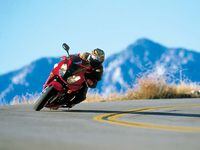


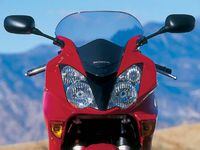
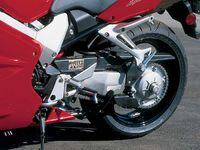

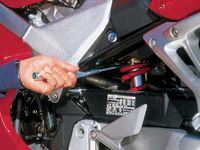

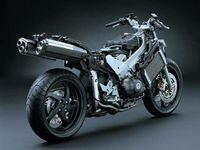
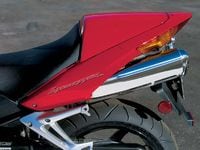
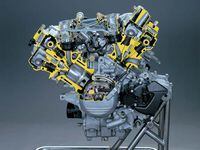


/cloudfront-us-east-1.images.arcpublishing.com/octane/VZZXJQ6U3FESFPZCBVXKFSUG4A.jpg)
/cloudfront-us-east-1.images.arcpublishing.com/octane/QCZEPHQAMRHZPLHTDJBIJVWL3M.jpg)
/cloudfront-us-east-1.images.arcpublishing.com/octane/HXOUJXQWA5HBHGRO3EMJIGFMVI.jpg)

/cloudfront-us-east-1.images.arcpublishing.com/octane/3TIWWRV4JBBOLDVGRYECVVTA7Y.jpg)
/cloudfront-us-east-1.images.arcpublishing.com/octane/KIX5O23D5NAIBGFXBN3327DKZU.jpg)
/cloudfront-us-east-1.images.arcpublishing.com/octane/7GJYDUIPXRGMTMQKN6ONYOLBOU.jpg)
/cloudfront-us-east-1.images.arcpublishing.com/octane/MUQLOVLL2ZDGFH25ILABNBXKTI.jpg)
/cloudfront-us-east-1.images.arcpublishing.com/octane/TNOU5DNE2BC57MFPMGN2EIDXAM.jpg)
/cloudfront-us-east-1.images.arcpublishing.com/octane/GTCXACQGJ5HAPDTGWUQKDEH44E.jpg)
/cloudfront-us-east-1.images.arcpublishing.com/octane/S35YGSEMEZB4BLTDJTSZPF4GLA.jpg)
/cloudfront-us-east-1.images.arcpublishing.com/octane/5UOT6HPX2JFMRJAX6EH45AR4MQ.jpg)
/cloudfront-us-east-1.images.arcpublishing.com/octane/OKWOJWAKP5EP3OACCRRWPCIX2Q.jpg)
/cloudfront-us-east-1.images.arcpublishing.com/octane/2WF3SCE3NFBQXLDNJM7KMXA45E.jpg)
/cloudfront-us-east-1.images.arcpublishing.com/octane/G4MG6OUCJNBSHIS2MVVOTPX65E.jpg)
/cloudfront-us-east-1.images.arcpublishing.com/octane/IIGGWFOTOJGB7DB6DGBXCCMTDY.jpg)
/cloudfront-us-east-1.images.arcpublishing.com/octane/QSTCM6AVEZA5JJBUXNIQ3DSOF4.jpg)
/cloudfront-us-east-1.images.arcpublishing.com/octane/U4I7G625B5DMLF2DVIJDFZVV6M.jpg)
/cloudfront-us-east-1.images.arcpublishing.com/octane/B6XD6LS6IVCQPIU6HXDJSM3FHY.jpg)
/cloudfront-us-east-1.images.arcpublishing.com/octane/ICL63FEDDRDTTMINYICCEYGMDA.jpg)
/cloudfront-us-east-1.images.arcpublishing.com/octane/FCGZHQXRBZFLBAPC5SDIQLVF4I.jpg)
/cloudfront-us-east-1.images.arcpublishing.com/octane/WNOB6LDOIFFHJKPSVIWDYUGOPM.jpg)

/cloudfront-us-east-1.images.arcpublishing.com/octane/X33NU3E525ECRHXLNUJN2FTRKI.jpg)